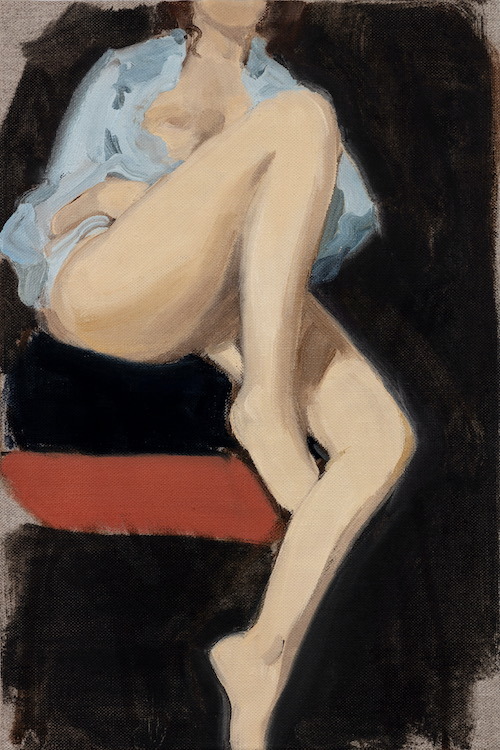#p: rubin
Explore tagged Tumblr posts
Text


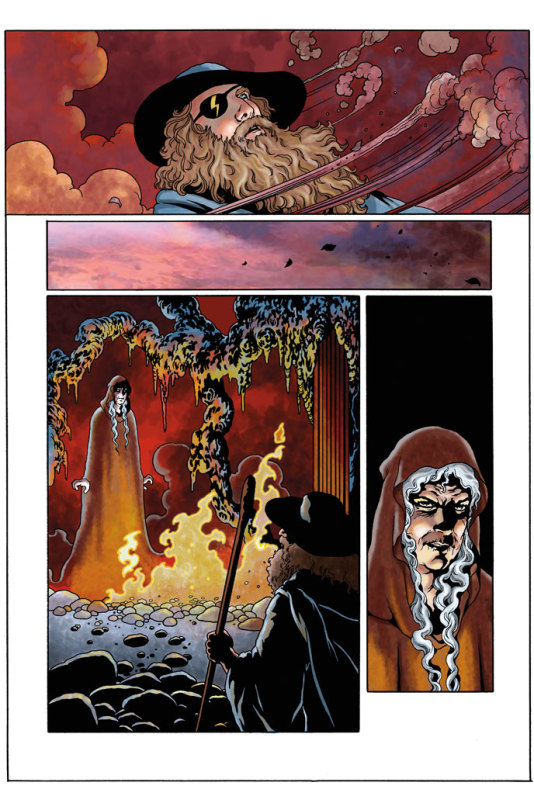
A few pages of Neil Gaiman's NORSE MYTHOLOGY. I thoroughly enjoyed working on this. It is very similar to the stylistic approach I am taking with GOOD OMENS - line art with color, though I think the art on GOOD OMENS is better overall.
The adaptation on this was by P Craig Russell, and the artists, including me, worked from Russell's layouts, which were very simple but perfectly designed.
The third volume in which my segment appears is now on sale. There is some great work by P Craig Russell, Galen Showman, and David Rubin in there. I particularly like David Rubin's color sense, it's just stupendous.
#neil gaiman#norse mythology#p craig russell#david rubin#galen showman#good omens graphic novel#good omens#dark horse comics
77 notes
·
View notes
Text
Rihanna > Beyoncé
#yeah it’s time to differentiate#because there is a difference#the difference is in quality of evolution and genuine superstar in you not on you or put on you via a respectability talking black dad#with typical black man baggage#shoutout the navy#and shoutout p Diddy and Jay z for sending Rihanna right after she got her ass beat by a bitchasscrackheadnigga on a beach with her abuser#for pr purposes for hip hop and bitchassniggas aka black men that have Lyor and Micheal Rubin’s types up their loose faggot assholes
1 note
·
View note
Text
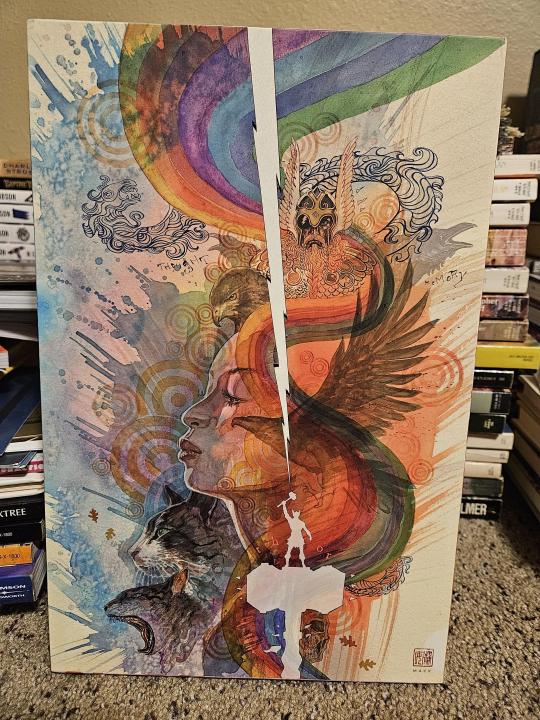

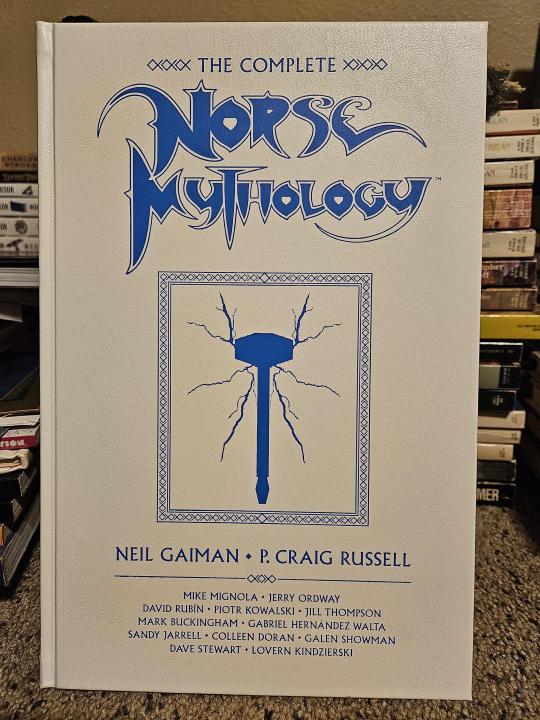
I was so busy being a depressed sad-sack piece of shit that I completely forgot this had shipped until the UPS guy tossed it on my front porch as I was getting ready to leave for work today.
#the complete norse mythology#norse mythology#neil gaiman#p. craig russell#mike mignola#jerry ordway#david rubin#piotr kowalski#jill thompson#mark buckingham#gabriel hernandez walta#sandy jarrell#colleen doran#galen showman#dave stewart#lovern kindzierski#dark horse comics#comic books
1 note
·
View note
Text
Dark Horse reveals The Complete Norse Mythology
Dark Horse reveals The Complete Norse Mythology #comics #comicbooks
Neil Gaiman’s 2017 bestselling book, Norse Mythology, has been adapted into an 18-issue comic series spanning three separate hardcover volumes. Now, Dark Horse Books will collect the entire series for the first time into one oversized, deluxe collection! The Complete Norse Mythology will include Volumes 1-3 of the comic series, adapted by P. Craig Russell, the Eisner award-winning writer,…

View On WordPress
#colleen doran#dark horse#dark horse books#dave stewart#david rubin#gabriel hernandez walta#galen showman#jerry ordway#jill thompson#lovern kindzierski#mark buckingham#matt horak#mike mignola#neil gaiman#norse mythology#p. craig russell#piotr kowalski#sandy jarrell#trade paperback#trade paperbacks
0 notes
Text

@bramblepatch that is a really great question and there's actually a cool answer! Chicago has a robust public art program that has invested in the weirdest shit possible. And that's the point!
So Chicago has a lot of extremely normal sculptures- lots of historical figures, Lincoln, Goethe, this extremely shiny Alexander Hamilton...
And then there's some... other stuff, and it's mostly Pablo Picasso's fault.
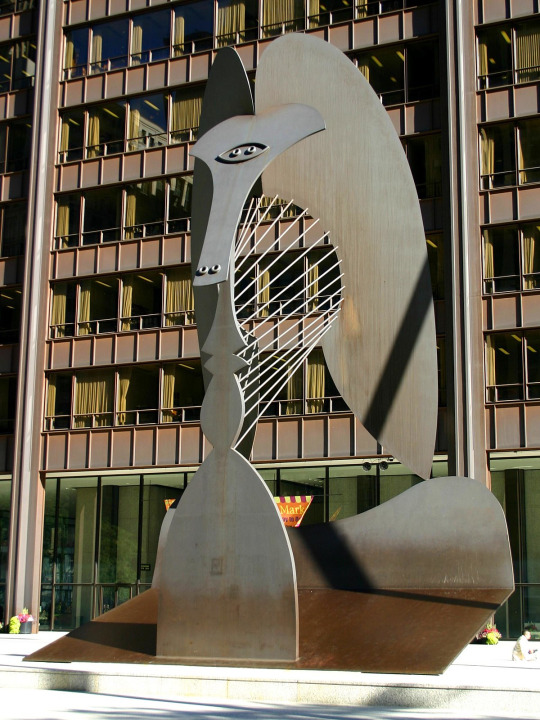
So up until the late 50s/early 60s, most of the public art in Chicago was just... y'know, what we think of as public art. But in '63, the folks at the Chicago Civic Center wanted something new and fresh, and so they commissioned Pablo Picasso to do... well, really whatever he wanted. So he made this thing and ended up donating the design to the city. And the city was STOKED because this was Pablo Picasso we're talking about here, and so they started doing things like having all these press events and displaying the maquette without copyright notice and long story short, they accidentally turned it into the public domain... and they kinda leaned into that! it's public art, after all!
Naturally, art critics hated it, so that only made the city lean in more! Let's push boundaries! Let's go weird and abstract! Let's experiment and do things that other cities aren't doing! The push to collect and house contemporary art in the city also got a boost from the foundation of the Museum of Contemporary Art in 1967 and the development of the Art Institute's modern collection.
Then the 1968 Democratic National Convention happened and the statue got even MORE famous because of the pig. Jerry Rubin, Phil Ochs, and the other Yippies held a press conference where they nominated a pig named Pigasus for president of the United States right before the DNC kicked off. They held this at the Picasso statue, and then they were arrested for disorderly conduct. Yes, the pig was also arrested. The pictures and controversy surrounding everything about that convention shoved the Picasso into the spotlight on an even grander national scale, and it really became a striking emblem of the city.
So all this attention to a piece of art that made people really question what public art should and could be really pushed a lot of dialogue and decisions about art that the city continued to accept and commission. After the Picasso came Flamingo in '74:

Four Seasons, also in '74:
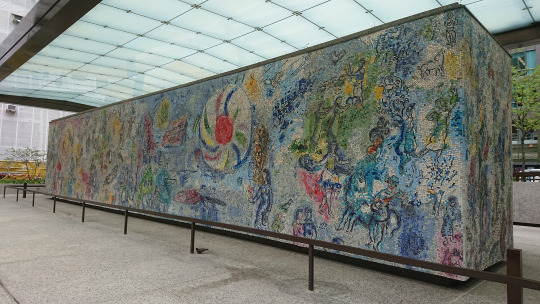
(less abstract but still VERY modern for civic art in what was the 2nd largest city in the country at the time)
Miro's Chicago in '79:
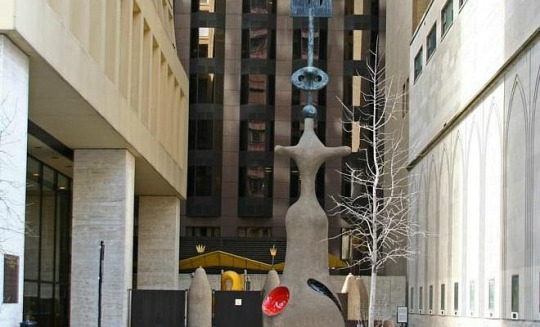
Monument with Standing Beast in '84:

And so on and so forth. This period of heavy investiture in large, public works of modern art helped cement Chicago as a place where contemporary art could thrive in public spaces- and we haven't really stopped! From Cloud Gate (the Bean) to Agora to a lot of neat, thought-provoking pieces scattered around the city. It's something I think is really cool, even if it did get us the nightmare that is Crown Fountain.
And if you want to read more about it, here's some more resources:
This guide is outdated, it's from the Rahm Emmanuel administration, but it has a lot of good pictures and locations for things. It also correctly uses the Sears Tower's name.
A couple of great blogs detailing and cataloguing Chicago's public art scene.
The Public Art Archive isn't Chicago-specific, but it has lots of collections to look at from cities all over the place!
A fascinating look at lost pieces of Chicago's public art- sadly, that now includes Monument with Standing Beast, since Google bought the Thompson Center and tore it down. (The Thompson Center had over 150 pieces of public art, an amazing collection... that's all in some state warehouse now. Hopefully it comes back or is displayed somewhere else that's public, since I'm not sure how much access we'll have to the Thompson Center once Alphabet moves in.)
Anyways I think public art is cool as hell thank you for reading this whole thing!
#chicago#modern art#disclaimer i am not an art historian#i just think it's neat#marge_holding_potato.jpg#long post
235 notes
·
View notes
Text
working on new drawings before i get back into cosmic p. - i will probably be clearing out my shop once these works are done to add these in so if you want anything from there, i'd recommend getting it sooner rather than later <3
https://buyolympia.com/Artist/sara+rubin
37 notes
·
View notes
Text
youtube
Fallen Angel / リグレットメッセージ (Regret Message) original music and lyrics by mothy / 悪ノP ballad version by 情熱P / てとてとarrangement by Desconico vocals by SOLARIA (Lite) on Synthesizer V Studio Basic from a VSQ by Hetachan/Rubin https://www.youtube.com/watch?v=8lzmoukr8cI tuning, mixing, video, illustration, additional vocals, and translation by Henrie Diosa
credits, links, and lyrics under the cut!
The Princess of Lucifer: on tumblr, on youtube His Significance of Existence: on tumblr, on youtube
SVPs and instrumental / off vocals: https://drive.google.com/drive/folders/17c_Zo2s6uQB4wSAzPRVpDUOjl-2qrNn6?usp=sharing
The folks on Ko-fi saw it first! I have a membership tier on Ko-fi that helps me afford meds and have the space to make art. I was also posting demos of the music and sketches of the art while I was making them. You can join the minamahal at ko-fi.com/henriediosa 💕
Image Credits: The Metropolitan Museum of Art Open Access "The Sea." Gustave Courbet. 1865. https://www.metmuseum.org/art/collection/search/436021 "A Vista through Trees - Fontainebleau." Narcisse-Virgile Diaz de la Peña. 1873. https://www.metmuseum.org/art/collection/search/436195
Lyrics: On the shore, at sundown At a harbor far from town A girl stands alone, dressed in brown and grey By this sea, deep and slow, There's a spell from long ago A secret we know but never say
You must whisper your wish To a little parchment roll And the bottle it goes into At twilight, go pray Let the sea take it away One day it will come true
Little bottle of glass, May my wish come to pass May my sins wash away with the falling tide Beyond sound, beyond sight Towards the dying light Like me, quietly cast aside
I was cruel and didn't see What you sacrificed for me To bring everything that I asked of you I was cold, I was vain And I never felt your pain After what I made you do
And now you are gone, And you're the only one Who'll make my wish come true My grief and heartache May the sea take them away Until the day I see you
Little bottle of tears, All my hopes and my fears Drifting further away with the falling tide Beyond faith, beyond fate May it not be too late May my tears pay the price of my pride
Little bottle of glass, May my wish come to pass May my sins wash away with the falling tide Beyond sound, beyond sight Towards the dying light Like me, quietly cast aside
Little bottle of tears, All my hopes and my fears And regret for the years that I spent in sin
If by some happenstance, somewhen in our next lives I would like a chance to play with you one more time
#Youtube#video#synthv#synthv english#synthesizer v#solaria#solaria lite#synthv solaria#evillious#evillious chronicles#悪ノP#mothy#allen avadonia#riliane lucifen d'autriche#translation#translyrics#story of evil#regret message#リグレットメッセージ
10 notes
·
View notes
Text
Interesting Papers for Week 20, 2024
Brain-imaging evidence for compression of binary sound sequences in human memory. Al Roumi, F., Planton, S., Wang, L., & Dehaene, S. (2023). eLife, 12, e84376.
Awake responses suggest inefficient dense coding in the mouse retina. Boissonnet, T., Tripodi, M., & Asari, H. (2023). eLife, 12, e78005.
Competing neural representations of choice shape evidence accumulation in humans. Bond, K., Rasero, J., Madan, R., Bahuguna, J., Rubin, J., & Verstynen, T. (2023). eLife, 12, e85223.
Overestimation in angular path integration precedes Alzheimer’s dementia. Castegnaro, A., Ji, Z., Rudzka, K., Chan, D., & Burgess, N. (2023). Current Biology, 33(21), 4650-4661.e7.
Predictive learning by a burst-dependent learning rule. Chapman, G. W., & Hasselmo, M. E. (2023). Neurobiology of Learning and Memory, 205, 107826.
Motor actions are spatially organized in motor and dorsal premotor cortex. Chehade, N. G., & Gharbawie, O. A. (2023). eLife, 12, e83196.
A complete reconstruction of the early visual system of an adult insect. Chua, N. J., Makarova, A. A., Gunn, P., Villani, S., Cohen, B., Thasin, M., … Chklovskii, D. B. (2023). Current Biology, 33(21), 4611-4623.e4.
Longitudinal evidence that infants develop their imitation abilities by being imitated. Essler, S., Becher, T., Pletti, C., Gniewosz, B., & Paulus, M. (2023). Current Biology, 33(21), 4674-4678.e3.
How associations become behavior. Ghirlanda, S., & Enquist, M. (2023). Neurobiology of Learning and Memory, 205, 107833.
Emotion regulation during encoding reduces negative and enhances neutral mnemonic discrimination in individuals with depressive symptoms. Hayes, B. K., Harikumar, A., Ferguson, L. A., Dicker, E. E., Denny, B. T., & Leal, S. L. (2023). Neurobiology of Learning and Memory, 205, 107824.
Representations of tactile object location in the retrosplenial cortex. Lande, A. S., Garvert, A. C., Ebbesen, N. C., Jordbræk, S. V., & Vervaeke, K. (2023). Current Biology, 33(21), 4599-4610.e7.
Informational feedback accelerates learning in multi-alternative perceptual judgements of orientation. Liu, J., Lu, Z.-L., & Dosher, B. (2023). Vision Research, 213, 108318.
History information emerges in the cortex during learning. Marmor, O., Pollak, Y., Doron, C., Helmchen, F., & Gilad, A. (2023). eLife, 12, e83702.
Mega-scale movie-fields in the mouse visuo-hippocampal network. Purandare, C., & Mehta, M. (2023). eLife, 12, e85069.3.
Theta-band phase locking during encoding leads to coordinated entorhinal-hippocampal replay. Santos-Pata, D., Barry, C., & Ólafsdóttir, H. F. (2023). Current Biology, 33(21), 4570-4581.e5.
Using multi-modal neuroimaging to characterise social brain specialisation in infants. Siddiqui, M., Pinti, P., Brigadoi, S., Lloyd-Fox, S., Elwell, C. E., Johnson, M. H., … Jones, E. J. (2023). eLife, 12, e84122.
Non-invasive temporal interference electrical stimulation of the human hippocampus. Violante, I. R., Alania, K., Cassarà, A. M., Neufeld, E., Acerbo, E., Carron, R., … Grossman, N. (2023). Nature Neuroscience, 26(11), 1994–2004.
Information search processing affects social decisions. Wei, Z., Liang, Y., Liang, C., & Liu, H. (2023). Journal of Behavioral Decision Making, 36(5), e2352.
Noninvasive theta-burst stimulation of the human striatum enhances striatal activity and motor skill learning. Wessel, M. J., Beanato, E., Popa, T., Windel, F., Vassiliadis, P., Menoud, P., … Hummel, F. C. (2023). Nature Neuroscience, 26(11), 2005–2016.
The locus coeruleus directs sensory-motor reflex amplitude across environmental contexts. Witts, E. C., Mathews, M. A., & Murray, A. J. (2023). Current Biology, 33(21), 4679-4688.e3.
#neuroscience#science#research#brain science#scientific publications#cognitive science#neurobiology#cognition#psychophysics#neurons#computational neuroscience#neural networks#neural computation
11 notes
·
View notes
Photo

Today in Hip Hop History:
Rick Rubin was born March 10, 1963
#today in hip hop history#todayinhiphophistory#hiphop#hip-hop#hip hop#hip hop music#hip hop history#hip hop culture#music#history#music history#rick rubin#birthday#music producer#producer#1963
119 notes
·
View notes
Text
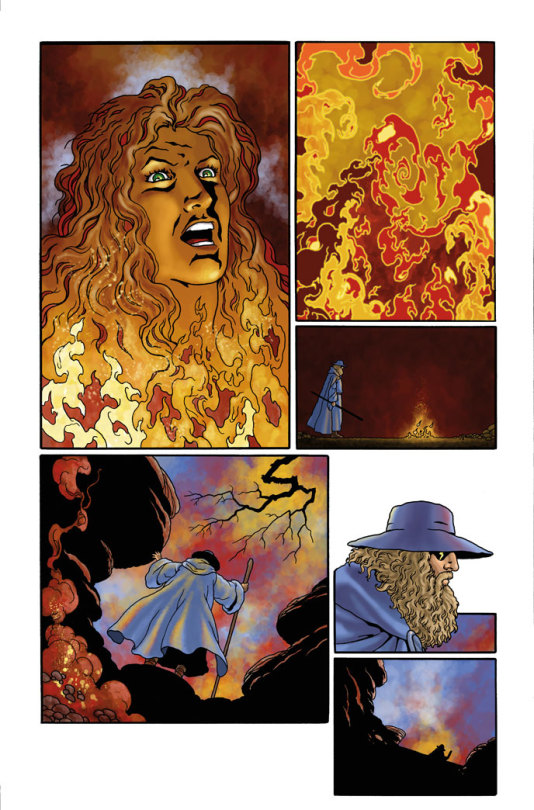
From Neil Gaiman's NORSE MYTHOLOGY Volume III adapted by P Craig Russell. Art on this chapter by me with letters by Todd Klein and thumbnails by P Craig Russell. Outstanding work on this book by David Rubin and Galen Showman, a real pleasure to be a part of this project.
61 notes
·
View notes
Text

#mark p photo
STILL ROCKIN’.
We post glorious pinups like this one all day, every day, all unique! If you dig this pic we’ve found online, u should investigate the creator/subjects of the work and fan them, follow them, hire them.
If you’d like us to remove, or you know who made this so that we can credit, DM. Thanks and greetings from Los Angeles.
YOU ARE THE LIGHT
Dr Rubin’s Pomade
2 notes
·
View notes
Text

Mme. Marcella Sembrich, whose successes as a star of the opera were followed by widely hailed achievements as the mentor of singers after her retirement in 1909 from the Metropolitan and from the concert stage in 1916, died at 8 A. M. yesterday in her home, 151 Central Park West. She was 76 years old. She had been ill since last Nov. 15, with her condition becoming progressively worse as she lost strength. For the last few days death, which was attributed to emphysema and heart complications, had been hourly imminent. So widely was she known, however, not only in New York City but also in other cities of the United States and abroad, that the foreknowledge of the end did not dim the shock of her passing. Persons who called at or telephoned to her home yesterday forenoon for| news of her condition were in-'| formed of her death, and then to)! the apartment began a steady succession of messages of condolence and of callers to express their grief.
Son Present at the End. Recently, Mme. Sembrich had been in such a weak condition that she had received no callers. With her at the time of her death were her son, William Marcel Stengel, and her daughter-in-law, Mrs. Juliette Stengel. Her husband, Wilhelm Stengel, died in 1917. She had no other close relatives in the) United States. Until the onset of her illness she had remained actively at work as a. teacher. During the Summer she) had conducted the school she had maintained for a number of seasons at Lake George, N. Y. Many satudents got instruction there from her | rich store of operatic accomplishment.
New York in October and took up her residence in her apartment,which overlooked , Central Park. She went forward as usual with her teaching. Since her illness, however, which at first took the form of asthma and interfered seriously | with her breathing, all of her contact with her students had been curtailed. To conserve her strength, the utmost quiet was prescribed by her physician, Dr. Charles Goodman Taylor. Friends said yesterday, however, that her advanced ace had from the first made her, illnes a matter of serious concern to them. : Her teaching contacts previously had been linked both with the Juilliard School of Music here, and) with the Curtis School in Philadelphia. She was a director of the, latter institution until last year, and was the recipient of a degree of Doctor of Music for her work there. In accordance with what was understood to be a wish of Mme. Sembrich, and of her family, the funeral services will be simple. The services, it was announced, will be held at 3 P. M. tomorrow in St.Patrick’s Cathedral. There will be. no special music, other than that, by the boys’ choir of the cathedral. The place of burial was not made known.
Active pallbearers were announced as Cornelius N. Bliss, Serge Rachmaninoff, Josef Hofmann, Ernest Hutcheson, Ernest Schelling, Frank Ia Forge, Wilfred Pelletier, André de Coppet, Walter Damrosch, Antonio Scotti, H. H. Flagler, W. J. Henderson, Richard Aldrich, Emilio de Gogorza, Edward Ziegler, Adolfo) Betti, Efrem Zimbalist and Paul D. Cravath. | Honorary pallbearers will be Giulio Gatti-Casazza, John Erskine, Francis Rogers, Alexander Siloti, Ugo Ara, Dr. W. H. Haskin, Adolph S. Ochs, Alfred Pochon, Rubin Goldmark, Sigismund Stojowski and Dr. J. A. Taylor.
When Marcella Sembrich sang her |farewell to opera on Feb. 6, 1909,her voice was young and beautiful. The final rise of the curtain that | night revealed her enthroned on | the Metropolitan Opera House) stage. Grouped about her was every member of the Metropolitan Opera Company. Facing her was an audience that filled every foot of floor space from the doors to the roof. Gifts were piled high beside her throne and great masses of flowers | stretched into shadows far down. the stage. “It is because I like the sun best | when it is high,’’ she said, in ex- | planation of her retirement. ‘‘It is | better that I leave when every one is asking ‘why?’ than later when. my ability might be less.’’ * She was then within nine days) of being 51 years old. She had | reigned at the Metropolitan for| more than a generation; she had/| typified for three decades here and| abroad the highest perfection of| bel canto singing. Just as Mme. Adelina Patti had done before her, she had kept alive the old traditions of Italian song, and with Melba she had carried on to increasingly greater heights the traditions of the old Italian mastery of the voice. She had found success early and it had lasted long. In her bright career was no place for anticlimax. She never could recall a time when music was not the chief interest of her life. There were piano lessons when she was 4 years old; lessons on the violin two years later. After she had developed a remarkable ability on both instruments recognition of her extraordinarily appealing and expressive colorature soprano voice came when she was 15. So she had, as Franz Liszt told her, ‘‘three pairs of wings to fly with through the land of music.”” ‘‘But sing,” he had ordered, ‘‘sing for the world, for you have the voice of an angel.’’ Music, poverty and endless work made up her childhood. She was born Praxede Marcelline Kochanska on Feb. 15, 1858, in the hamlet of Wizniewczyk, Galicia, Poland. Her father, Kasimir Kochanski, one of fourteen children of a tanner, had run off and joined a military band. Leaving to marry, he had learned to play all the musical instruments and was able to make a passable living by his skill.
The family made up a home quartet. Her mother, whose maiden name was Sembrich, played second violin, her brother first violin, the father a ‘cello and Marcelline the piano. They wandered about seeking pupils. As the daughter grew older she played piano to her father’s violin in the homes of the minor nobility and rich townsfolk, Always very poor, they had to borrow the scores of Haydn and Mozart, and the daughter worked by candlelight, copying the parts. She was 12, alert and confident, a self-supporting artist—she lived very cheap—when she met her first patron. A wandering singer of folk-songs, Father Lanovich, liked her instrumental accomplishments so much he helped her to enter the conservatory at Lemberg. In three years one Wilhelm Stengel, instructor of piano, taught her all he had to teach. He took her to Liszt and the great man talked of her wings. He gained her a hearing wit: Epstein, who accepted her as a student of piano and to Helmesberger, under whom she studied the violin. He took her to Rochitansky, in Vienna, under whom she _ studied voice. Then, when she was 19 years old and ready for her début he married That year of her début and marriage, 1877, she wintered in Milan, learning from the younger Lamperti that Italian ‘‘bel canto’’ which she was later to make her special art. To Milan then as now came impresarios seeking singers. Marcelline had two offers. One would have taken her to Tiflis, across the Black Sea. The other called to Athens and she accepted it. The night of her début was June 3, 1877. It was very hot; the opera was at Phaleron by the sea. The King entered the royal box and the opera, “‘I Puritani,’’ started. The new singer was well received, but ee was no great sensation about it.
In the next year advisers on her musical career worked. over her name and molded it into Marcella Sembrich. She appeared as Sembrich at the Saxon Royal Opera at Dresden and had an immediate and tremendous success. A two-year engagement in Dresden followed.
Then she made her London début at Covent Garden in 1880. It was in ‘Lucia’? and the critics reported that London was dazzled by her vocalization. A season of grand opera in Madrid followed directly and then the first of fifteen seasons in St. Petersburg and Moscow. Those were great days for the opera. The gracious applause of royalty was important and thrilling then. The young singer had much of it. Orders and decorations and royal gifts began overwhelming her. But in 1883 she left Europe for New York.
She came in stirring times. A war was on between the old and the rew. Insurgents from the old citathe Academy of Music, had joined with considerable recent wealth to build the Metropolitan Opera House, familiarly known As the ‘‘White Elephant,’’ where every one with enough money could sit in a box and show off gowns and jewels. Adelina Patti was retained by the old; Christine Nilsson by the new. | Marcella Sembrich, then only 25) years old, rated next to Nilsson in| in “‘Lucia,’’ the second opera it, gave, and sang Patti’s roles. By the end of the season the critics could find no praise too She was not, of coursé, favored above Patti. When Patti Sang the Academy was two-thirds For Patti was was Queen of But Marcella Sembrich did make a real place for herself. Her great night of that first year was April 21, 1884. Henry E. Abbey, impresario for the Metropolitan, had found hard going that first year. He had gambled on exrensive productions and lost heav‘- .. A benefit was given for him. The littl. girl whose father could play all the instruments in the band showed off her three pairs of wings. She sang an aria from ‘“‘La Sonnambula,’” she played a nocturne by Chopin and furnished the violin obbligato to Gounod’s ‘‘Ave Maria,’’- sung bv Miss Nilsson. One critic the next day described her as a “‘meteor in a galaxy of More Singing Lessons, England and many long tours of the Continent followed. She appeared in opera and concerts in St. Petersburg, Moscow, Warsaw, Berlin, Paris, Madrid and lesser capitals, sharing the first honors of Italian opera with the most distinguished artists of her generation and with the great ones who had been famous when she was still playing for dances in Galicia. In 1897 she came back to America for a concert tour, and in ovember, 1898, rejoined the Metropolitan Opera Company. In the Metropolitan’s répertoire she made the operas of the florid Italian school inevitable. In the succeeding seasons she lost none of her vocal powers. Several stars of the last generation made their debuts by her side. She reappeared as Gilda on Nov. 23, 1903, for Caruso’s American début as the Duke in ‘‘Rigoletto’’ and she sang with him in his first successes. There were several reasons why she retired in 1909, when her career was at zenith, when she was winning the operatic honors and popularity that were to be equaled only by Caruso. One was that fashions in opera had changed. In her younger days, as she put it, you just came out In your nicest evening frock and sang. But by 1909 the dramatic opera had pretty much taken the place of lyric opera and she found that while the public had once wanted to hear only the old operas sung over and over again, they then wanted ‘‘a new role every week.’’
For some years. after retirement from opera she continued in concert tours both here and abroad. ‘“‘Gradually,’’ she had said in re-calling the period, “I began to feel the desire of transmitting to the younger generation of today the art that I had learned so thoroughly. and practiced so long.’’ After the death of her husband in 1917 she withdrew entirely from the public platform and devoted her time and energy exclusively to teaching. Aspirants came to her and she selected and labored over the most promising. Stars of the Metropolitan and other companies came also; ‘‘for inspiration,’’ they always said, but Sembrich’s aides ‘the ichestra, she appealed to the public knew they were seeking perfection. When the Juilliard Foundation was established in New York and the Curtis Institute of Music in Philadelphia she was called to head the departments of voice. In the succeeding years at New York, Philadelphia and at her estate in Lake George pupils from all over the world assembled for her tutelage. She gave many stars to the musical | firmament. Her most. successful pupils included Dusolina Giannini, Queena Mario, Alma Gluck, Hulda Lashanska, Harriet van Emden, Ethyl Hayden, Florence Page Kimball and many others. Her great hope in the last few years of her life was that America should have a national opera— opera through a movement that should reach out to every part of the country, bringing to the nation the culture that goes hand in hand with musical development. It would utilize American talent and its productions would be entirely in English. It was on behalf of this movement that she appealed to the public béginning in 1930 when the depression threatened the American opera. First her efforts were in behalf of the American Opera Company. Then she returned to the stage of the Metropolitan on Feb. 26, 1933, at the jubilee stage show, and begged her old friends to help the Metropolitan, urging the company and its followers to ‘‘carry on.”’
For the Metropolitan, as well as Philharmonic-Symphony Oragain on her seventy-sixth birthday on Feb. 15, 1934. Paderewski, her friend of many years’ standing, sent her the following message on this birthday: ‘‘Most affectionate. wishes and greetings to the greatest and noblest artist and friend, from Paderewski."’ Except for such occasions, and in addition her chairmanship of the Polish-American Relief Fund during the war, she remained in retirement from the public eye. But in the world of music, even to her last days, retirement was not for her. She occupied a position in American music such as Liszt had in the Weimar days. Musical notables came to her studio, her ‘“‘trophy room,” as she called it. Surrounded by mementos of Brahms, Verdi, Rubinstein, Gounod, Thomas, Paderewski, Modjeska, Joachim and Clara Schumann and others of the great artists who had worshiped her talent, she was sought for the gospel of perfection with which she inspired fellow-musicians. In those last years most of her time was spent in America, her Winters in the apartment facing Central Park, replete with cherished reminders of her lifelong triumphs; her Summers at Lake George at the estate she had established with her husband and teacher, and-to which they used to repair in the early days of her retirement. She was one of the really great personalities in the music world, one of the great ones whose sun was always high.
#classical music#opera#music history#bel canto#composer#classical composer#aria#classical studies#maestro#chest voice#Marcella Sembrich-Kochańska#Marcella Sembrich#Marcelina Sembrich-Kochańska#Covent Garden#Royal Opera House#Metropolitan Opera#Met#dramatic coloratura soprano.#dramatic soprano.#coloratura#the Polish Nightingale#the Nightingale#the Polish Patti#Polish Patti#classical musician#classical musicians#classical history#history of music#historian of music#musician
3 notes
·
View notes
Text

GENESIS P-ORRIDGE "WISDOM CAN ONLY BE PASSED ON BY THE TOUCHING OF HANDS" @ RUBIN MUSEUM, NYC // 2016
#genesis p-orridge#sculpture#hands#contemporary art#black and white#monochrome#NYC#art#photography#u
26 notes
·
View notes
Text
Happy Valentine's Day!! 💝 (+ long personal ramble lmao)
Well I did intend on posting earlier than this, but I wanted to wish a big happy Valentine's to everyone who actually follows along with the random crap that I post on this site-- and an especially big hug to all of my fellow aspec, arospec, and aroace lovelies!! I've always valued the celebration of all forms of love on February 14th, whatever dumbass society that we live in who decided that it's strictly a holiday for romantic couples can show themselves out the mfing door. Romantic love, platonic love, familial love, s*xual love, queerplatonic love, polyamorous love, animal love, ALL types of feeling & showing love are so wonderful and deserve to be celebrated!! If you feel sad about being single on Valentine's Day, don't let our stupid economy blind you to how loved you are in many different ways by many different people!! 🫶
On that note, this year marks a very meaningful occasion for me personally. I'm currently 21 years old, I learned I was asexual when I was 16 and didn't understand that I was arospec too until I was 20. I've always been totally content either celebrating Valentine's Day with my close friends, or basically ignoring the day all together. But as of last summer, I am now in my first Queerplatonic relationship with my incredible partner @rubinaitoart (and our beloved @lovelucigoosey, who is always with us 🎗️🩵) and I thought that today would be a fitting day to finally proclaim my cheesiness online lol! Rubin, I love you so so much and I'm seriously so lucky to have you. Thank you for being my very first Valentine's Day partner, for making me feel so loved I nearly happy-cry every time, and for just always being your supportive, talented, caring, funny, amazing and beautiful self!! 💜💜💜 /p
My patience to see your smile and give you the biggest hug face-to-face is dwindling with every day, but also knowing that we will get there someday is one of my favourite things to think about :'D To my online besties, Checkmate or otherwise, thank you for being the best long-distance found family I could ever ask for!! Every one of you guys means the world to me, I'm so grateful that you all put your care and energy toward a little chatty bundle of emotions like me. My bucket list purely consists of a list of each of you guys, and I will not quit until I get to properly see and hug all of you or else your name is not getting checked off of the bucket list!! But yeah fr thank you guys I fuckin' love my friends I don't know how I got so lucky 🥹💕
To my kittens (not that I expect they'll be reading this), thank you for being such little fluffballs of joy and chaos. Thank you for coming upstairs and insisting to check on me when I have been face-deep in homework for 6 hours, and for dragging me away for cuddles whenever I need it. To my parents (who definitely won't be reading this XD), thanks for being some badass and wonderful parents.
To Luci, I mean I check in pretty often so you probably already know what I'm gonna say. I hope you're happy, I hope you're smiling, I hope you're running and I hope you're free of pain. Love you always boo 🩵
I just have so much love in my heart that I wish I could share as much as possible. I love my family and my kittens and my friends from university who help keep me somewhat sane. I love my Discord friends/found family who help keep me very sane, and are always there to make me laugh and to celebrate achievements together. I love my queerplatonic boyfriend/partner, I love his voice and his hair, I love his obsession passion for The Arcana, I love his fluffy puppy Aster, I love how he makes me smile and that I'm capable doing the same.
Thanks guys. I really really love you all ❤️
...
(Also I haven't slept in like 38 hours and I'm struggling to stay awake as I write this so I hope it is at all legible, it's probably too long but quite frankly if you read the entire thing and made it all the way down here then massive kudos to you. I did warn that I was chatty and emotional, those two traits never go well together 😂)
7 notes
·
View notes
